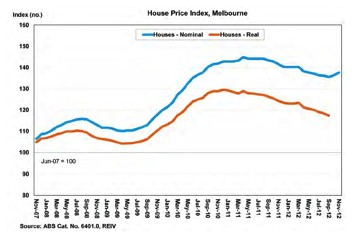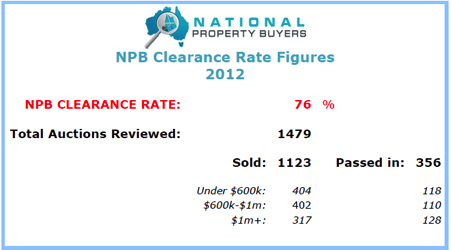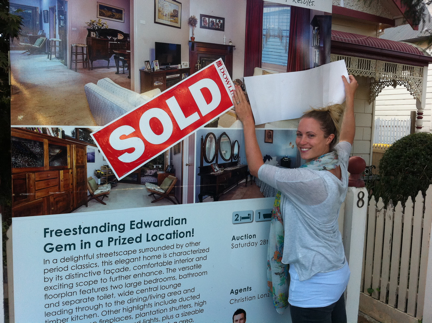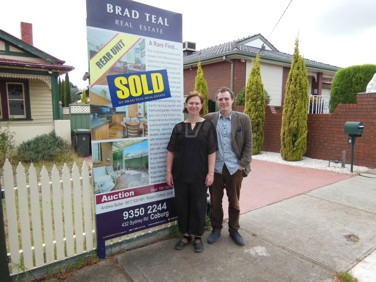In this edition:
A year of sensationalist media headlines, but did it end well for Melbourne’s property Market?
A light hearted look at the Reality behind Realty
NPB End of Year clearance figures
What’s Hot? We take a look at the Top NPB suburbs of the year
Why choose NPB? – Get it from the source! Read what our clients have to say

Speculation has been rising in the housing industry since the RBA cut the official cash rate by -0.25 per cent. The figure now sits at the post GFC 2009 ’emergency’ level of 3 per cent – leaving many in the industry hoping it will stimulate the market and inflate property prices as we move into 2013. Consumer sentiment is still wavering which should taper any immediate potential for growth. However, to assess if the environment is complementary for another post GFC “housing boom,” a broader outlook needs to be evaluated.
However, as has been broadly noted, the standard variable mortgage rate remains some 0.6-0.8 percentage points above that of 2009 during which it was sitting at 5.55 per cent and prices were rising sharply. Additionally, the strong Aussie dollar is still affecting our terms of trade, and although unemployment data has improved of late, (falling to 5.2 per cent in November 2012 from 5.4 per cent in October – albeit this week’s figures may reverse the trend) Victoria’s results aren’t so positive.
In Victoria, a series of job cuts announced by building products maker ‘Boral’ who shed 90 positions in their plant near Geelong a number of weeks ago, and additionally from major companies such as Qantas, who announced the loss of 263 positions from their Avalon base late last year, and most recently, ‘BlueScope Steel’ who announced a further cut of 170 jobs from their Western Port facility in Hastings, took Victoria’s jobless rate to 5.5 per cent from a previous 5.4 per cent – a figure which will no doubt increase and go some way in restraining any potential house market gains in this region throughout 2013.
Vendors on the other hand are fairing a little better. October was the fourth consecutive month and longest period to date during which more mortgages were discharged than lodged. This brings the annual decrease of mortgages to 1,998 which when compared to 2011, is an increase of 726 discharges.
It’s therefore clear that sentiment surrounding the future stability of our economy remains cautious, with most taking advantage of any extra cash, to save and pay down existing debt, rather than increase their financial burden.
Buyers on the other hand are equally cautious, and despite the ‘bumpy’ road of rises and falls recorded weekly in R P Data’s ‘Daily House Price Index’, we’ve ended the year in a similar position to where we started. Clearance rates are only marginally higher than last year averaging at 61 per cent (compared to 59 per cent at this time 2011) – total transactions marginally lower (roughly 4 per cent), and a State median house price of $530,000 in contrast to last year’s median of $540,000.
Final REIV data for the December quarter will be released later this month therefore it’s yet to be assessed if the “Christmas rush” will bring the median higher. However, RPData’s figures have already recorded a quarterly drop for Melbourne of -1.6 per cent.
The Christmas period is the busiest of the year – it provides a natural deadline for home buyers desperate to make their move prior to the January break (during which the real estate industry takes its long awaited ‘annual breather.’)
Traditionally over the Christmas period, only coastal properties and holiday homes continue to enjoy a spending spree of positive enquiry – although in the current atmosphere of ‘debt aversion,’ it’s unlikely we’ll see overwhelming activity even in this sector of the market.
Post Christmas most are recovering from too much food, drink and weighty credit card debt to pay the property market much attention – however for those buyers who avoided the pre-Christmas furore, January can provide a relative competitive free environment to secure comparatively excellent deals.
Even with the latest drop in rates, It’s unlikely we’ll see prices edge higher ‘until’ the RBA respond to the major consensus of opinion from economists, and choose drop the cash rate again in February (as it’s all but expected they will.)
Speculation that growth in the economy will fall to 2.5 per cent during the year ahead – well below the usual trend of 3-3.25 per cent – is why many are ‘assuming’ a further -0.25 to -0.50 per cent drop is needed if we’re to stimulate the ‘non-mining sectors’ of our economy.
Should this occur, and the banks ‘pay it forward,’ it will take lending rates low enough to provide a greater incentive for potential property investors to make their move – (especially considering long term deposit accounts will no longer provide a viable alternative option.)
As always – for the investors trying to ‘time’ the market the question should be whether to step in now and pre-empt further cuts in the cash rate, or play a waiting game, at which point the property market may already have started responding to any extra demand.
Catherine Cashmore
Highlighting the West

It’s always good to keep on top of where prospected population growth and government infrastructure projects may induce a ‘boom’ in median house prices.
Some recommend looking at newly created suburbs; however ‘new estates’ in regional areas only attract the necessary demand needed to inspire short term growth when generous FHB incentives are on offer. Outside of cash stimulated environments, market prices inevitably retract to their correct ‘supply/demand’ values.
Furthermore, evidence generally underlines that owner occupiers – and for that matter investors – prefer purchasing established over new which goes a long way to underpinning prices in this sector of the marketplace.
Over the last decade to 2011, 92 per cent of all borrowing by residential property investors was for established dwellings – slightly higher than the 82 per cent of borrowing by owner-occupiers during the same period.
Therefore, when looking for future hotspots – the preference should always be to seek out areas which are already ‘settled’ with land built out to avoid any new oversupply. It’s also important to focus on suburbs that contain a basic level of infrastructure which insures against any reduced activity from the “home buyer” sector during downward phases of the property cycle.
The other ‘needed ingredient’ when looking for a potential ‘boom’ in growth, is ‘affordability.’ If median prices in a suburb fall below, or close to the metro median – the price point at which the majority demand circulates – there’s a good chance this alone will maintain buyer interest and provide a good platform for growth when future gentrification occurs.
In Melbourne, the western suburbs – when judged by distance from the CBD – are currently undervalued compared to their south-eastern counterparts. As a quick example, the median house price in Prahran – 5km south-east of Melbourne’s CBD is $945,500. However Yarraville, which is a similar distance ‘west’ of the CBD has a median house price of $615,000. Both suburbs provide a comparable level of amenity, and both have attractive streetscapes lined with single fronted Victorian and Edwardian homes.
The difference remains that the ‘west’ still carries a ‘stigma’ because the eastern states were Melbourne’s original and favoured ‘market garden’ settlements – they contain the popular shopping strips, such as ‘Chapel and Acland Street’ and based on historical data, clearly maintain consistent home buyer demand through all phases of the property cycle.
However, this doesn’t mean the tables can’t turn – as affordability bites, and the population increases, the western suburbs stand to capture the ‘overflow’ stimulated by demand from ‘new households’ feeling the bite from rising values.
In addition to this, the State Government has ‘committed’ to providing their ‘west link project’ to facilitate the current and prospected population growth into the western regions. The new ‘east west link’ will connect the Eastern Freeway to City link, and connect City Link to the Port of Melbourne (as well as a connection from the port of Melbourne to the Western Ring Road.) In addition to this, a 9km rail tunnel project is planned, which is prospected to provide five new underground stations.
Information on the project provided by State Government reads as follows:
“Dedicated regional tracks will be built from West Werribee Junction to Deer Park, then along the existing rail corridor from Sunshine to Southern Cross Station. When completed, passengers on the Geelong, Bendigo and Ballarat lines will have a streamlined journey through the metropolitan system. Both metropolitan and regional passengers will get more services during peak time.”
As a buyer advocate – when searching for suitable real estate for the home buyer demographic – (the sector of the market willing to stretch an extra 20K – 30K for their property of choice which consequently pushes prices northwards) – the number one ‘must have feature’ is easy access to public transport.
Currently both metropolitan and regional trains moving through the Werribee, Sydenham, Craigieburn and Upfield lines, and the Geelong, Bendigo and Ballarat services share the same train tracks. This results in significant congestion during peak periods.
Demand on the Geelong line, has increased some 150 per cent over recent years – however, frequent disruptions to the train service, has deterred large scale migration from prospective home buyers, which would have naturally intensified house price growth.
Once the new infrastructure gets underway, I expect home buyer demand to increase substantially, which will inevitably cause a rise in property prices. In addition – businesses in the area will also benefit for which extra employment opportunities will be another stimulant to growth.
Therefore, my recommendation for investors would be to ‘look west’ and in particular Geelong – where prices are still affordable compared to the metro median and the attraction of the ‘bay’ as well as Deakin’s Geelong Waterfront Campus will keep rental demand consistent.
Catherine Cashmore
Spare a thought for the Sales Agent – a lighthearted look at the Reality behind Realty

You may have seen various job listings advertising a job in real estate as a sales agent. They are usually adorned with wording to the effect of;
Want the chance of earning $100,000+ in your first year!?
Passionate about Real Estate?
Like working with people and have great communication skills?
They are all questions most of us would be able to answer with a positive response.
After all, everyone wants to earn a healthy wage.
Nearly all jobs require good communication skills, and as for a passion for real estate? – Well it’s quite simply essential to our daily needs! A place for shelter, but also a place to express our territorial instincts, adorning our homes with elaborate renovations played out in both reality and fantasy – either with a trip to ‘Bunnings’, or through the guilty pleasure of watching one of the many ‘top rating’ renovation shows on TV.
However what is the life of a Real Estate Sales agent really like?
Does it live up to the hype?
Is it possible to earn wages in excess of $100,000 working for your ‘passion’, whilst at the same time enjoying working in the community?
Well not surprisingly like most jobs, the fantasy is hardly representative of the experience. It’s well known most people have a ‘low’ opinion of real estate sales agents. There’s even an ad doing the rounds which states;
“My son is dead – well… he’s a real estate agent.”
Sales agents are branded as untrustworthy and ‘slimy’ – driving around in their fancy cars which many imagine have been purchased with overly ‘fat’ commissions taken from ‘innocent’ vendors for what most perceive to be ‘minimal’ work.
In the latest ‘Readers Digest’ 2012 list of ‘most trusted professions’ released annually, real estate agents barely make the cut above ‘car sales’ people. In fact they sit just one step above a ‘sex worker’ – which ponders the question ‘why would anyone take their clothes off in front of someone they trust less than a real estate agent?’
However enough of that – having worked as a ‘buyer agent’ for many years, it’s not uncommon to get many customers signing up for the service simply because they don’t want to deal with the sales agents. For the buyer at least, when they meet a sales agent, there’s this uncomfortable feeling they’re ‘out to get you’ – or at least empty your wallet.
It was interesting to see an article in New Zealand’s ‘Sunday Star Times’ recently debating whether sales agents should be required to ‘tell the truth’ when representing a property to buyers. In the article, Helen O’Sullivan – chief executive of the REINZ – was reported making a submission to Parliament that the
“Consumer Law Reform Bill could cause ‘confusion’, rather than protect consumers.”
It follows the premise that sales agents may not always know the truth regarding a listing with one of their agencies. However, no one’s asking an agent to convey information they don’t know. Even if a piece of information relayed to them by the vendor is false, it’s not lying to pass it on – it’s down to the buyer to conduct their own due diligence when it comes to assessment – hence why buyer advocacy is becoming a ‘peace of mind’ option for those who lack the time and ability to do so. After all, few would consider splashing a couple of grand out for a flat screen TV or laptop, without doing a comparative analysis of competing offers.
Thankfully – in Victoria at least – the Estate Agents (Professional Conduct) Regulations 2008 – SECT 11, states
All this aside, all you really need to understand as a consumer is – the selling agent works for the vendor. Not unlike any sales agent, whilst you won’t get lies, you won’t get the ‘negative’ side of the story either. No property is perfect – beauty is firmly in the eyes of the beholder – however the sales agent is there to represent the positive – not to point out the flaws.
However is it worth coming bottom of Readers Digest polls?
Well for some, the answer is undoubtedly ‘yes’ – however easy it’s not. There’s no doubt sales agents are somewhat compromised through the ‘commission only’ model – or even the current alternative ‘flat fee’ model. After all, they’re not going to get paid unless they sell the property – even if that means a little ‘vendor crunching’ along the way – and in truth, most vendor’s have high expectations to say the least. What’s the alternative? Perhaps a ‘pay by the hour’ model – ‘pay for service’ and take commissions out of the equation to start with.
However, to last the road, a sales agent must build trust with their vendors. Without it, building up a referral database (the main source of business for any agency) would be impossible. Therefore, existing on a roll call of needless exaggerations is simply not a reasonable strategy no matter what the perception.
Not only this, the common perceptions of real estate agents not working hard are far from the mark (at least for those who desire to be successful). I’ve often pondered that the advert for employment as an agent’s representative should begin;
‘Are you prepared to give up your weekends for the foreseeable future?’
Because a career in real estate – especially when you start – will ask you to do precisely that!
Saturday’s will be spent opening houses, conducting auctions (especially if you live in Melbourne or Sydney), trying desperately to tie up a deal so you can report a positive result to the boss during the traditional Monday morning sales meeting.
But it’s not just Saturdays you’ll give up. Many vendors also expect their agents to be on hand Sunday as well! This means whilst everyone else is kicking back spending time with the family in shorts and thongs (well in the summer months anyway!) the local agent will be standing in suit and jacket – rain or shine – donning a smile and welcoming ‘house shoppers’ and nosey neighbours who only get the weekends to take a squiz at their short list of homes.
Well that’s not so bad I hear you cry?! Don’t agents get a ‘week-day’ off to compensate?
Well yes – most do, but bear in mind whilst the agent may have a week day ‘reprieve’, it doesn’t mean the phone will stop ringing!
A real estate agents business is largely conducted over the phone. Friday may be their day off – but no one else will know it. You may think an agent should just turn the phone off? However it’s very hard to do when you work in a job solely reliant on commissions.
Turn the phone off, and the buyer calling may decide to contact someone else in the office about the house they’re interested in. If so, you won’t get the commission should they purchase.
And even worst – what if it’s someone calling for a “free” market appraisal – a potential seller? Well that’s a call you can’t afford to miss.
Sellers are a real estate agents ‘bread and butter’. If an agent doesn’t list, the agent won’t last!
As for the ‘open home’, well merely conducting the operation is a joy to behold. Most agents have as little as 15 minutes to get from one listing to another and against all odds, they can’t risk being late! (Not an easy task for anyone who may have noticed that weekend traffic is often worst than that during week days).
The vendor is essentially the agent’s boss, so they won’t be happy if the agent doesn’t show up for work on time. Especially when they’ve spent the last three hours scrubbing and cleaning in an effort to create a ‘show home’ master piece – all for the sake of a 30 minute ‘open’.
Should an agent dare to leave more time in between opens – once they get to open number ‘9,’ they’ll be an unhappy vendor wondering why their property is not being opened until 5pm, when everyone else has ‘knocked off’ for the night??
The 15 minutes must also include finding a parking spot at each end of the street and popping the ‘open for inspection’ boards out (if you live in an area that allows them). For the sake of timing this often requires stopping ‘mid road’ switching the emergency lights on whilst struggling with a board ‘flapping’ in the wind – and invoking anger from drivers attempting to ‘squash’ past.
Struggling with the keys – setting out the brochures and switching all the lights on – more often than not, with a queue of impatient buyers waiting outside to hand out names and numbers (which invariably turn out to be false) is another ‘perk’ of the job.
As a sales agent, you’ll have to don a permanent smile whilst at the same time, pretending the train line running so close behind the house that the whole place ‘rattles’ as it passes, isn’t really a negative because you can’t hear it when the windows are shut and after all – it’s so handy being close to the station!
Situations like this are all part and parcel of the job.
Neither does an agent turn off in the evenings. Work hours prevent most buyers from conducting private inspections during daylight hours. Yet if they’re interested enough to purchase a property, a private inspection is often a must. This means the agent will be required to work late – long after other workers have ‘clocked off.’
The agent’s mobile phone number is present on every advert – and most agencies will require the agent to use their existing mobile for business (few provide an office phone) therefore it’s also their personal ‘out of hours’ number.
Most of us wouldn’t give out mobile numbers unless it was to a personal contact – someone we generally wouldn’t mind contacting us ‘out of hours’. However an agent happily hands his number to hundreds of people each week knowing full well there’ll be a proportion of those buyers who’ll take full advantage of the privilege. As I said earlier – it’s ‘all well and good’ turning the phone off – however miss a call and you risk missing potential ‘commission’ from an active purchaser or seller!
But let’s get to the crunch – what about the $100,000+ a year wage??
Contrary to popular belief, most sales agents are on no more than $60,000/$70,000 a year, and when they initially enter the business, the starting wage is more like $30,000-$35,000 per year. This is because an agent typically works for a minimum retainer, which – when I last checked – is little more than $500 per week.
The retainer must cover most expenses, including a smart car and ‘expensive’ looking suit – (a well accepted requirement in the industry to at least give the ‘impression’ of professionalism and expertise.) Therefore it will come as no surprise to learn many agents’ cars are leased – not owned – and the younger ones (in their 20’s) usually still live at home.
As for the retainer – well in essence it’s little more than a ‘loan’. Once a commission is earned – any wages received in the interim will be deducted before it’s handed over to the agent. Remember sales commissions aren’t commonly paid until settlement, therefore the lag between the accrued retainer and commission can be a number of months.
Average Commissions differ from state to state and seem large to the home owner who often hands in excess of $10,000, $20,000 or $30,000 to the agency upon settlement. However the sales agent only receives a small proportion of this – often only 2,000 or 3,000, therefore considering the hours they work it’s not all that great.
Furthermore – when an agent initially starts his career in real estate, it’s not unusual for it take up to and beyond a year, to consistently earn in excess of the basic retainer. Any hint of a $100,000+ a year salary is firmly reserved for those who’ve weathered through 5 years or more in the industry, building up contacts and often working 7 days a week in the process.
However – by far the greatest fear for an agent is the ‘white board’ which is erected at the back of the office citing what each agent has sold or listed for the month.
If they fall behind on expected output, the director will start to question their use to the agency. An agent can be sacked with as little as two week’s notice if the boss doesn’t think they’re ‘paying for their desk’.
Yet real estate is a competitive business. It may be easy to pick up listings for the agent who’s worked in the industry for a period of years with a substantial database of contacts. However for those starting out, often the only way to get in front of a seller is to literally walk the streets. Knock on doors, post leaflets through letter boxes, whilst avoiding those with ‘No Junk Mail signs’ for fear of upsetting a potential vendor!
Every enquiry an agent receives from a potential buyer will be followed with the desperate and hopeful question
‘Do you have a home to sell’ – ‘Do you require a ‘free, no obligation‘ market appraisal?’
Anyone entering the business better have a thick skin to combat all the angry responses and disappointments.
Real estate sales is a highly competitive industry – especially in inner city precincts. When the initial ‘free’, no obligation market appraisal is booked in, most agents will be up against at least two competitors. With the fear of the white board ever present in mind, it’s no wonder one agent will aim to promise more than another when it comes to their estimation of the homes potential sales price. (Commonly known as ‘buying the listing’)
Once the vendor has signed on the dotted line, the real work begins.
The agent won’t get paid a cent, if he or she doesn’t sell the property – therefore encouraging the vendor to ‘meet the market’ (known in the business as ‘vendor education‘) – (no matter what was promised prior to the contract being signed) – is, of course, common practice.
Should the agent’s authority period run out on the contract (the period of time the vendor has given the agent to sell the property) before they’ve managed to get both the ‘’potential’ buyer and seller to agree on price. Then for all the accrued hours they’ve worked – (standing in a suit conducting open homes, taking questions from buyers, conducting the auction, and so forth) – the sales agent will get nothing!
More likely than not, the vendor will head to an opposing agency who are (of course) promising a successful result from ‘just the right buyer’ sitting on their database.
Therefore, if an agent has to risk being disliked by their vendor or an interested buyer to get the deal done, (spinning a few exaggerations along the way), it’s no surprise many feel forced to do so.
As for holidays, well in the world of real estate they are few and far between. Aside from the odd long weekend, or Easter break, the main holiday period in the real estate industry, is Christmas. It’s the only time an agency can acceptably ‘close’.
Therefore, in the run up to Christmas agents will work harder than ever to wrap up sales and line up potential listings for vendors not making the pre Christmas deadline.
The last thing an agent wants is a property looking ‘tired’ as it hangs on the internet over the festive break slipping further down the ‘default search’ list on realestate.com.au.
Furthermore, they’ll want to collect as much commission as possible for their own festivities, therefore, a deal done prior to Christmas means extra dollars in the holiday bank account.
All in all the life of an estate agent is a tough one, and only really rewarding for those who truly love, live, and breathe property (and there are a few!).
The ‘real dollars’ come years down the line once the hard yards have been walked and the reputation of ‘experience’ earned. At that stage, the agent in question is often established enough to afford a ‘PA’ to conduct the weekend opens and answer all enquiries.
Therefore, next time you pop through an open home, spare a thought for the agent, who sits at the lower end of most people’s perceptions, yet lives a reality very different from what you may perceive!
NPB end of year Clearance Figures

The NPB clearance rate is a snapshot of ‘investment grade’ or ‘cream of the crop’ properties representing only those we recommend to clients.
These are properties that hold the best potential for a long term capital growth and rental demand.
Whilst the Real Estate Institute of Victoria include all properties scheduled for auction (as reported by their members) – including those that are poorly located and unlikely to attract demand even in a robust climate; our clearance rate is far more representative of the narrow sector of the market that represents our client’s best interests. As such, properties that fall into this category only account for roughly 5% of the total ‘stock on market’ at any one time.
The clearance rate is naturally higher than the REIV’s figures – however NPB’s clearance rate has ended the year in broadly the same position as it began – with only small variations in the data since the beginning of 2012.
The median house price is now over $500K in all suburbs within 10km of the CBD – therefore family home buyers are increasingly heading into middle – and what were previously considered – ‘outer ring’ suburbs to secure houses adequate for their family’s needs.
Therefore we’ve seen the strongest growth in areas which a few years ago, would have been off the radar for investors. Areas such as Doncaster, Doncaster East, Vermont/Vermont South and Watsonia, for example. Coincidentally, the REIV clearance rate for these suburbs is also above the state average.
Doncaster has an REIV clearance rate of 74 per cent and an NPB clearance rate for quality properties in this suburb of 82 per cent.
Vermont South an REIV clearance rate of 68 per cent and an NPB clearance rate of 86 per cent.
And Watsonia has an REIV clearance rate of 68 per cent and an NPB clearance rate (due in part to fewer auctions that take place in this suburb) of 100 per cent.
The strongest performing sector of the market remains below $1m, with duel income couples and families with children making up the major home buyer demographic.
Luxury homes will continue their struggle to gain traction. Sellers attempting to get premium prices for well renovated houses above $1 Million are playing a game of Russian roulette – especially if they choose to sell their properties by auction.
In this scenario, they are solely reliant on at least ‘two’ buyers ‘falling in love’ with the property in order to achieve a ‘top of the range’ price.
Therefore, results aren’t consistent and depend on circumstance rather than market forces.
Even with interest rate drops and a slight improvement in housing affordability, it’s unlikely we’ll see any immediate changes to the market terrain in the first quarter of 2013. However, the market has firmed as the year ends, and presents a stable platform of relative good buying conditions in which investors can advantage.
Catherine Cashmore

NPB – What’s HOT!
Abbotsford flying with a NPB Clearance Rate of 100%
Abbotsford remains top of the list in our rundown of NPB top suburbs by clearance rate. It’s a popular suburb for a younger demographic of home buyers with a relatively high population of ‘owner-occupiers’ considering its proximity to the CBD.
Roughly 38 per cent of the market rent whilst the rest either own their homes outright, or hold mortgages on properties they have purchased.
The pre-dominant dwelling type generally falls into two categories – semi-detached homes (townhouses on little more that 200 sqm of land) and apartments.
Housing is diverse, with a large proportion of converted warehouses which retain solid appeal for a broad fraternity of home buyers.
Therefore the predominant buyer demographic tends to be young childless couples (with only a small population – roughly 10 per cent of children under the age 15 and adults over the age of 65.)
It’s worth noting, auctions – in any significant volume – only take place in the inner suburban locations of Melbourne’s real estate market, and therefore outer suburbs are not represented in this list.
The top 10 NPB performing suburbs by clearance rate – for which there have been a minimum of 12 properties reviewed – are as follows:
Abbotsford 100%
Bentleigh East 93%
Balwyn 88%
Brunswick 87%
Armadale 86%
Box Hill North 82%
Elwood 82%
Fitzroy 85%
Ascot Vale 71%
St Kilda 80%
Catherine Cashmore
Why choose National Property Buyers? We let some of our clients have the last word!
Below are just some of the many letters of thanks we receive from our clients for a service we remain proud and passionate to provide.

“My wife and I were first time home buyers with no experience of the Melbourne Property market, we asked NPB for help with negotiation for some selected properties in our area. We were introduced to Robert was diligent and helpful in the initial process, and achieved some very quick results.
During the negotiation process Robert was thorough in explaining the potential hazards and implications of various aspects of the negotiation. As a result of Roberts work we were able to secure the first house on our preferred list for well below our budget for the property including NPB fees, and below the average for similar properties in the area.
Many thanks!”
“Dear Antony, Robert and Catherine,
Congratulations to you all for your professional and personal manner in all dealings with myself and my family. Your continued support and advice was invaluable to me and I will not hesitate to recommend National Property Buyers to anyone.
I found that you made the often stressful and difficult experience of purchasing a new home, a much easier and pleasurable time where I was able to share both concerns, worries and happiness. I am sure there were many times when I contacted, or met with you both together and individually in a stressful manner and I certainly appreciated your professional advice, calm and personal manner in which I was treated.
Thank you all.”

“A quick note to say a very sincere thank you for your assistance in purchasing our home. It seems somewhat surreal at present but I am very pleased. You have made this experience an incredibly positive one!
Thanks again, chat soon.”
“We can hardly find words to express how grateful we are to you for your outstanding service which led to us purchasing the Irvine Crescent unit yesterday. You are so incredibly knowledgeable and competent in your field. We trusted you completely and felt very secure having you advising us and acting for us. We don’t want to think what the process and outcome of looking for an investment property would have been like without you!
Thank you so much for all your work for us. We have been recommending you to others and hope that we will have the chance to retain you again in the future. Our very best wishes and deepest gratitude.”

“You took the time to figure out what we wanted and were constantly updating us with your progress!
Even when we went overseas on holidays, we could still bid on a property with both of you standing in for us.
We will definitely be calling on your services for our next property!”

To read more testimonials from our clients, please click here.
Subscribe to NPB’s Melbourne Property Market Weekly Update

EVERY week Antony Bucello, State Manager of NPB and Catherine Cashmore, Senior Property Consultant & Melbourne Market Analyst, provide expert commentary on what has happened over the weekend including facts and figures from the REIV and from NPB’s exclusive clearance rate snapshot of premium investment grade listings.
If you are not already receiving weekly updates and would like to subscribe, click here.
Contact Us
If you wish to discuss your property buying, selling or management needs, please don’t hesitate to contact us. Alternatively, you may prefer to complete our Help Us Help You online form and we will contact you.
